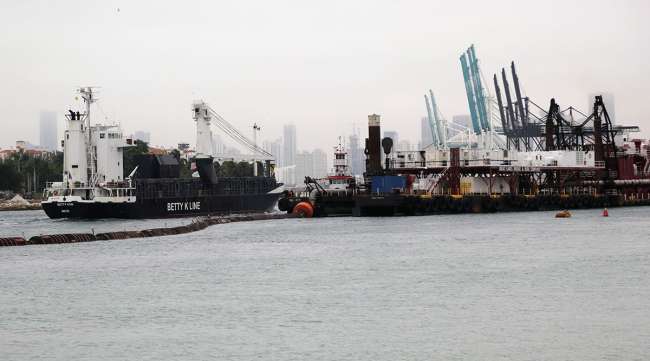PortMiami Seeks to Expand Three Years After Controversial ‘Deep Dredge’ Project

The super ships are coming, and PortMiami — set in an aquatic preserve at the north tip of Biscayne Bay — says it needs to get bigger.
While the scope of the work remains uncertain, enlarging the busy port just three years after completion of the previous $205 million “Deep Dredge” is sure to set off another skirmish over potential damage to sea life from digging up the bottom of the shallow bay. Earlier this year, the U.S. Army Corps of Engineers agreed to settle a lawsuit with environmentalists over damage to coral.
This time around, the fight may well come down to what’s more valuable to South Florida: dollars from megaships or the health of the only inshore reef tract in the United States that also protects the coast from hurricanes.
“To have to go through this again when we don’t even know the extent of the damage … is irresponsible,” Miami Waterkeeper Executive Director Rachel Silverstein said.

Port of Miami. (Lynne Sladky/Associated Press)
But the Army Corps of Engineers, which will oversee the work, has vowed to learn from past mistakes and in a meeting this week to launch a three-year, $3 million study to determine the scope of the projects, invited input from the public as well as scientists for help.
“This is really a snapshot on a long list of lessons learned,” project manager Laurel Reichold said after reviewing the 2015 dredge, which she said state and federal environmental regulators still are reviewing.
The two-year, 50-foot dredging that raised repeated concerns after environmentalists began documenting damage to coral and surrounding seagrass struggling in cloudy water as 5 million cubic yards of bay bottom was barged offshore. In anticipation of the potential damage, the Corps had obtained an environmental permit from federal regulators that allowed it to kill some protected staghorn coral.
This time around, Corps officials said they hoped to have more transparency, mitigate potential damage up front, collaborate more with other agencies and better understand how sediment could spread as muddy bottom was dumped offshore.
“Reporting of the monitoring data was too slow and we know that now,” Reichold said.
The move to dredge the port again was prompted earlier this year when harbor pilots began complaining that the super ships now sailing through an expanded Panama Canal were having trouble turning. Although Corps engineers knew those ships were coming, Reichold said they were not factored into 2004 design work because the Corps was ordered to get the work done quickly when the project finally was funded in 2012 after dragging on for nearly 17 years.

A $2 billion tunnel was also a part of the previous port project. (J Pat Carter/Associated Press)
“That would have been the time to … stop and reassess. That was not done because it was being conducted under the ‘We Can’t Wait’ initiative by the administration at the time. And so we can’t wait and so thou shalt proceed based on your 2004 economic analysis,” she said.
Port officials say they also anticipate even bigger ships, with drafts larger than 50 feet and carrying even more cargo.
Since mid-2016 and the collapse of a major South Korea shipping company, the cargo industry has shrunk to about a half-dozen companies that account for 70% of the business and favor larger, more cost-effective ships. As the only port south of Virginia able to service big ships, port officials say they need to continue with improvements to maintain that hold.
Harbor pilots also say struggles negotiating turns have led to delays in port operations and required some ships to schedule arrivals weeks in advance.
At this week’s meeting, Capt. Jonathan Nitkin, chairman of the Florida Harbor Pilots board of directors, said bringing in bigger ships and keeping the port vital should trump the reef.
“Everything you eat, wear or use comes through this port,” he said. “There’s reefs everywhere. The purpose of this project is to make this deep dredge really work with reality.”
Environmentalists disagreed.
“The shortsighted notion that by sacrificing the reefs in this location is inconsequential is a fallacy,” said Andrew Baker of the University of Miami Rosenstiel School of Marine and Atmospheric Science. Baker, a coral biologist, is looking for ways to make disappearing reefs more resilient to warmer and more acidic oceans caused by climate change.
We need to sit down and say what are the economic drawbacks of these projects.
Sierra Club Conservation Chairman Drew Martin
Besides their economic value — calculated at about $3.3 billion in 2003 — reefs off South Florida are populated with many species that live at the northern edge of their range. As oceans warm, Baker said that limit is moving north, making the corals invaluable to scientists trying to understand how climate change on reefs will play out.
“They’re right at the cusp at the leading edge of the migration, and we’re about to destroy them,” he said.
Over the next 18 months, they’ll nail down the scope of the project and determine, using ship safety simulations, exactly where more dredging needs to occur. Once that’s done, they can begin to determine how big the project might be, and how much it will cost.
“We are at the drawing board. We’ve got some study objectives. We’re looking at what is necessary. But we haven’t done any of the ship simulations,” engineer Jason Spinning said. “We haven’t done all the things we need to do, so at this time we’re asking for the public’s input to help us craft this project.”
When they calculate benefits, environmentalists hope they’ll also update the value of the reefs, and the cost the dredge might impose.
“We need to sit down and say what are the economic drawbacks of these projects,” Sierra Club Conservation Chairman Drew Martin said. “I don’t think we always know.”
Distributed by Tribune Content Agency, LLC


